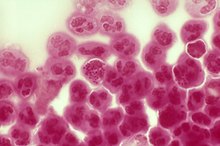What Are the Treatments for Serratia Bacteria?
Serratia marcescens is a common bacterium that can cause a number of serious opportunistic infections in hospital patients 1. Patients fitted with catheters are especially susceptible to this type of bacterial infection, as are newborn children and infants. Fortunately, there are effective ways to treat Serratia infections, and to prevent them altogether 1.
If you are experiencing serious medical symptoms, seek emergency treatment immediately.
Serratia Infections
Normally, Serratia marcescens causes generic infections in wound sites, as well as the urinary tract, respiratory system and eyes 1. For a urinary tract infection, the symptoms might include itching, burning discharge, and pain in the kidneys. Symptoms of respiratory infection include sore throat and nasal and chest congestion.
Serratia marcescens can also cause more dangerous infections if left untreated 1. At its most severe, Serratia marcescens can cause pneumonia, meningitis, arthritis and other serious illnesses 1.
- Normally, Serratia marcescens causes generic infections in wound sites, as well as the urinary tract, respiratory system and eyes 1.
Treatment
A List of Fungal Diseases
Learn More
As with most types of bacterial infection, the main treatment for Serratia marcescens is antibiotics 1. And like many bacterial strains, Serratia marcescens is resistant to certain types of antibiotics 1. Taking the correct medication is, of course, the key to getting healthy.
As of August 2010, Serratia marcescens is resistant to ampicillin, macrolides and first-generation cephalosporins 1. According to eMedicine, the preferred treatment for Serratia marcescens is an aminoglycoside such as amikacin, along with an antipseudomonal beta-lactam such as cefpirome 1. Other effective antibiotics include gentamicin, quinolones and the newer cephalosporins. However, recent studies show that Serratia marcescens is beginning to show resistance to gentamicin, so the latter drugs may prove more effective at clearing the infection 1.
In some cases, Serratia infection can cause abscesses, which are inflamed, pus-filled areas that occur at an infection site (e.g., the lung) 1. Abscesses resulting from Serratia may require surgical drainage in addition to treatment with antibiotics 1.
- As with most types of bacterial infection, the main treatment for Serratia marcescens is antibiotics 1.
Prevention
Serratia marcescens is found almost everywhere in nature, but it prefers damp conditions 1. For this reason, it is often found in bathrooms, where it is thought to cause the pink film sometimes found in showers and sinks.
In order to prevent Serratia infections, protective wear, hand washing, and proper sterilization of medical instruments—especially respiratory devices and catheters—are essential 1. Maintaining a clean bathroom environment is also important.
- Serratia marcescens is found almost everywhere in nature, but it prefers damp conditions 1.
- In order to prevent Serratia infections, protective wear, hand washing, and proper sterilization of medical instruments—especially respiratory devices and catheters—are essential 1.
Related Articles
References
Writer Bio
An avid lover of science and health, Meg Michelle began writing professionally about science and fitness in 2007. She holds a bachelor’s degree in physics from Creighton University and master’s degree in science writing from Johns Hopkins. Her work has appeared in publications such as EARTH Magazine.








